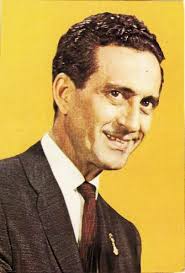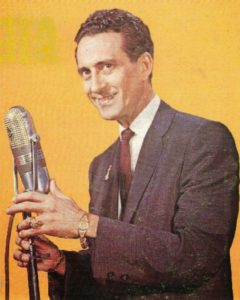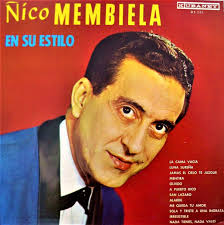 “ÑICO” MEMBIELA, UNO DE LOS MÁS GENUINOS BOLERISTAS DE TODOS LOS TIEMPOS. VIDEOS.
“ÑICO” MEMBIELA, UNO DE LOS MÁS GENUINOS BOLERISTAS DE TODOS LOS TIEMPOS. VIDEOS.
Francisco Antonio Membiela García nació en Zulueta, Villa Clara, Cuba, el 3 de diciembre de 1913, conocido artísticamente como Ñico Membiela es considerado uno de los mas genuinos boleritas hispano parlantes de todos los tiempos.
Tocó marímbula y bongó en un sexteto de sones. Sobre 1929 con 16 años de edad, comenzó a cantar como trovador en Sagua la Grande. Después pasó a Cienfuegos donde hizo dúo con Félix Molina y en Santa Clara con Juvenal Quesada, tratando de lograr un espacio en medios radiales.
Guitarra en mano, el joven y muy delgado Ñico Membiela, con una salud precaria desde la temprana juventud, tenía coros de amigos y muchachas que le admiraban y se ponían a escucharle las canciones que incorporaba a su repertorio. De Cienfuegos se mudo a La Habana. Su fama surgió a finales de los años cincuenta y principios de los sesenta. Sus antiguos vecinos de la calle Santa Elena sonreían al verlo pasar en su Cadillac cada vez que era contratado para cantar en el Hotel Jagua, del que fue una de las figuras más frecuentes en su cabaret Guanaroca, recién inaugurada la instalación.
Para 1942 está en La Habana. Comienza a cantar en la emisora Radio Salas y permanece en ella por cinco años, y comparte la radio con funciones en cabarets y centros nocturnos. En 1951 hizo varias grabaciones para el sello PANART, pero no obtiene éxito con ellas.
Posteriormente graba con la Orquesta de Cheo Belén Puig en 1954 y se da a conocer, pero su popularidad comienza en 1960 con la grabación de dos boleros unidos en una misma obra “Contigo-Besos Salvajes”, que se convierte en un éxito rotundo en todos los medios musicales cubanos. Se presentó en el conocido “Ali Bar”. Grabó varios discos y continuó sus presentaciones en los mejores centros de La Habana.
En 1963 viaja a México y después a Estados Unidos, donde se radica y continúa labores en cabarets. Grabó varios discos en Estados Unidos, con orquestas dirigidas por Pepe Delgado, Juanito Márquez, Swing Casino de Rafael Sori, así como con la Orquesta Casino de Tampa.
Ñico ya tenía una larga carrera pero sin ser reconocido tanto como merecia, junto a Blanca Rosa Gil y Orlando Vallejo se convierten en los principales boleristas que noche tras noche el público acudía a aplaudir en el Ali Bar.
En 1963 se presenta en México y de ahí se marcha a Estados Unidos presentándose en diferentes ciudades.
El bolero que lo llevó a la cima de la popularidad fue “Contigo-Besos Salvajes”, realmente una combinación de dos piezas musicales, “Contigo”, del mexicano Claudio Estrada y “Besos Salvajes”, una especie de tango de discutida autoría, la combinación melódica tuvo un arreglo tan bien logrado que al oído suena como si se tratara de una sola canción, de un único tema, y no de la combinación de dos melodías preciosas.
Este estelar y muy particular bolerista falleció el 13 de julio de 1998 a la edad de 85 años, estando fuera de su país desde 1963, en la ciudad de Miami, donde se había establecido.
Ñico Membiela popularizó el bolero titulado “Boxeo de amor”, de Juan Arrondo, que era muy solicitado entre las peticiones del público que asistía a sus conciertos. El disco fue grabado para el sello Modiner y fue de las últimas grabaciones que hizo en Cuba, con “Falsa”- “Hoy sé más por la otra cara”; ambos boleros fueron tremendos éxitos en las victrolas y en las emisoras más importantes de La Habana como Radio Cadena Habana.
La etapa del bohemio sencillo que tantos conocieron y pocos hoy, por la inclemencia del almanaque, quedan para rememorar. Dejó de existir, pero para siempre se le reconoce como uno de los más representativos intérpretes del bolero de la primera mitad del siglo XX, hasta entrada la década de los setenta. Quien se precie de ser amante y conocedor de los boleros tiene que recordar obligatoriamente a Ñico Membiela.
No obstante todos los años que han transcurrido desde que grabó sus principales y añorados éxitos y desde su desaparición física, es prácticamente una obligada referencia cuando se habla de boleros y de sus grandes intérpretes de todos los tiempos.
DISCOGRAFIA.
Temas mas Conocidos.
Serenata A La Madre
Mi Virgen Negra.
Contigo – Besos Salvajes,
Orgullo,
Lo Siento Por Ti,
Nosotros,
Boxeo De Amor,
En Las Tinieblas,
Dos Cosas
entre muchas otras.
 “ÑICO” MEMBIELA, ONE OF THE MOST GENUINE BOLERISTS OF ALL TIME. VIDEOS.
“ÑICO” MEMBIELA, ONE OF THE MOST GENUINE BOLERISTS OF ALL TIME. VIDEOS.
Francisco Antonio Membiela García was born in Zulueta, Villa Clara, Cuba, on December 3, 1913, artistically known as Ñico Membiela is considered one of the most genuine Spanish-speaking boleritas of all time.
He played Merimbula and Bongo in a sextet of sones. About 1929 with 16 years old, he began singing as a troubadour in Sagua la Grande. Then he went to Cienfuegos where he duo with Félix Molina and in Santa Clara with Juvenal Quesada, trying to achieve a space in radio media.
Guitar in hand, the young and very thin Ñico Membiela, in poor health from early youth, had choirs of friends and girls who admired him and began to listen to the songs that he incorporated into his repertoire. From Cienfuegos, he moved to Havana. His fame emerged in the late 1950s and early 1960s. His former neighbors on Calle Santa Elena smiled when they saw him pass in his Cadillac every time he was hired to sing at the Hotel Jagua, of which he was one of the most frequent figures in his Guanaroca cabaret, the facility had just opened.
By 1942 he is in Havana. He began singing on the Radio Salas station and stayed there for five years, and shared the radio with functions in cabarets and nightclubs. In 1951 he made several recordings for the PANART label, but he does not obtain success with them.
Later he recorded with the Cheo Belén Puig Orchestra in 1954 and made himself known, but his popularity began in 1960 with the recording of two boleros united in the same work “Contigo-Besos Salvajes”, which became a resounding success in all Cuban musical media. He appeared at the well-known “Ali Bar.” He recorded several albums and continued his presentations in the best centers of Havana.
In 1963 he traveled to Mexico and later to the United States, where he settled and continued working in cabarets. He recorded several albums in the United States, with orchestras led by Pepe Delgado, Juanito Márquez, Rafael Sori’s Swing Casino, as well as with the Tampa Casino Orchestra.
Ñico already had a long career but without being recognized as much as he deserved, together with Blanca Rosa Gil and Orlando Vallejo they become the main bolero players that night after night the public came to applaud at the Ali Bar.
In 1963 he appeared in Mexico and from there he went to the United States appearing in different cities.
The bolero that took him to the top of popularity was “Contigo-Besos Salvajes”, really a combination of two musical pieces, “Contigo”, by the Mexican Claudio Estrada and “Besos Salvajes”, a kind of tango of controversial authorship, The melodic combination was arranged so well that it sounds to the ear as if it were a single song, a single theme, and not a combination of two beautiful melodies.
This stellar and very particular bolero player died on July 13, 1998, at the age of 85, having been abroad since 1963, in the city of Miami, where he had established himself.
CURIOUS FACT.
Ñico Membiela popularized the bolero titled “Boxeo de Amor”, by Juan Arrondo, which was in great demand among requests from the public attending his concerts. The album was recorded for the Modiner label and was one of the last recordings he made in Cuba, with “Falsa” – “Today I know more on the other side”; Both boleros were tremendous successes in the victrolas and in the most important radio stations in Havana such as Radio Cadena Habana.
The stage of the simple bohemian that so many knew and few today, due to the inclemency of the almanac, remains to be remembered. He ceased to exist, but he is forever recognized as one of the most representative interpreters of bolero from the first half of the 20th century, until the late 1970s. Anyone who boasts of being a lover and connoisseur of boleros must necessarily remember Ñico Membiela.
Despite all the years that have passed since he recorded his main and longed for successes and since his physical disappearance, it is practically a must-see reference when it comes to boleros and their great performers of all time.
READ NICO MEMBIELA DISCOGRAPHY AND PERFORMANCES IN THE SPANISH SECTION ABOVE).
Agencies/ Wiki/ Ecured/ Maria A.Vizcaino/ Internet Photos/ YouTube/ Arnoldo Varona/ www.TheCubanHistory.com
THE CUBAN HISTORY, HOLLYWOOD.










